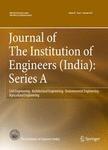版权所有:内蒙古大学图书馆 技术提供:维普资讯• 智图
内蒙古自治区呼和浩特市赛罕区大学西街235号 邮编: 010021

作者机构:Department of Design Durgapur Steel Plant Steel Authority of India Limited West Bengal Durgapur713203 India Department of Civil Engineering National Institute of Technology Durgapur West Bengal Durgapur713209 India Structural Engineering Laboratory Department of Civil Engineering National Institute of Technology Durgapur West Bengal Durgapur713209 India Structural Analysis and Design Department West Bengal Kolkata700055 India
出 版 物:《Journal of The Institution of Engineers (India): Series A》 (J. Inst. Eng. Ser. A)
年 卷 期:2024年第105卷第2期
页 面:317-329页
核心收录:
学科分类:12[管理学] 1201[管理学-管理科学与工程(可授管理学、工学学位)] 08[工学] 0805[工学-材料科学与工程(可授工学、理学学位)] 0813[工学-建筑学] 0814[工学-土木工程] 0803[工学-光学工程]
主 题:Scanning electron microscopy
摘 要:In the present experimental investigation, an attempt has been made to utilize fly ash in different proportions in combination with kaolin clay and fire clay to develop sustainable refractory brick. Six different types of sustainable refractory bricks were cast by combining and replacing kaolin clay and fire clay with 10%, 20%, and 30% of fly ash, respectively, adding 4–6% of water. Semi-dry mixed mortar was hydraulically pressed to make bricks using a friction press machine and burnt in the electric furnace at 950 °C and 1150 °C and in the tunnel kiln furnace at 1350 °C. The bulk density, apparent porosity, and refractory properties viz. cold crushing strength, and linear shrinkage tests were performed on the prepared bricks. The microstructural characteristics have been investigated using X-ray diffraction and field emission scanning electron microscopy analysis. The favorable test features suggest that there is an option to use fly ash up to 20% in the production of moderate heat duty refractory brick. Field emission scanning electron microscopy and X-ray diffraction analysis indicate that usage of fly ash in place of fire clay or kaolin clay up to 20% aids in vitrification, which results in high cold crushing strength. © The Institution of Engineers (India) 2024.